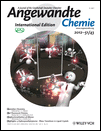A Phenylboronate-Functionalized Polyion Complex Micelle for ATP-Triggered Release of siRNA†
Mitsuru Naito
Department of Materials Engineering, The University of Tokyo, Hongo 7-3-1, Bunkyo-ku, Tokyo 113-8656 (Japan) http://www.bmw.t.u-tokyo.ac.jp/
Search for more papers by this authorDr. Takehiko Ishii
Department of Bioengineering, The University of Tokyo (Japan)
Search for more papers by this authorDr. Akira Matsumoto
Institute of Biomaterials and Bioengineering, Tokyo Medical and Dental University (Japan)
Search for more papers by this authorDr. Kanjiro Miyata
Division of Clinical Biotechnology, Center for Disease Biology and Integrative Medicine, The University of Tokyo (Japan)
Search for more papers by this authorDr. Yuji Miyahara
Institute of Biomaterials and Bioengineering, Tokyo Medical and Dental University (Japan)
Search for more papers by this authorCorresponding Author
Dr. Kazunori Kataoka
Department of Materials Engineering, The University of Tokyo, Hongo 7-3-1, Bunkyo-ku, Tokyo 113-8656 (Japan) http://www.bmw.t.u-tokyo.ac.jp/
Department of Materials Engineering, The University of Tokyo, Hongo 7-3-1, Bunkyo-ku, Tokyo 113-8656 (Japan) http://www.bmw.t.u-tokyo.ac.jp/Search for more papers by this authorMitsuru Naito
Department of Materials Engineering, The University of Tokyo, Hongo 7-3-1, Bunkyo-ku, Tokyo 113-8656 (Japan) http://www.bmw.t.u-tokyo.ac.jp/
Search for more papers by this authorDr. Takehiko Ishii
Department of Bioengineering, The University of Tokyo (Japan)
Search for more papers by this authorDr. Akira Matsumoto
Institute of Biomaterials and Bioengineering, Tokyo Medical and Dental University (Japan)
Search for more papers by this authorDr. Kanjiro Miyata
Division of Clinical Biotechnology, Center for Disease Biology and Integrative Medicine, The University of Tokyo (Japan)
Search for more papers by this authorDr. Yuji Miyahara
Institute of Biomaterials and Bioengineering, Tokyo Medical and Dental University (Japan)
Search for more papers by this authorCorresponding Author
Dr. Kazunori Kataoka
Department of Materials Engineering, The University of Tokyo, Hongo 7-3-1, Bunkyo-ku, Tokyo 113-8656 (Japan) http://www.bmw.t.u-tokyo.ac.jp/
Department of Materials Engineering, The University of Tokyo, Hongo 7-3-1, Bunkyo-ku, Tokyo 113-8656 (Japan) http://www.bmw.t.u-tokyo.ac.jp/Search for more papers by this authorThis research is supported by the Japan Society for the Promotion of Science (JSPS) through the “Funding Program for World-Leading Innovative R&D on Science and Technology (FIRST Program).”
Graphical Abstract
PIC-ing a winner: siRNA encapsulated by a phenylboronate-functionalized polyion complex (PIC) micelle shows binding between the phenylboronate and the 3′ ribose of the siRNA (see scheme), stabilizing the complex under conditions equivalent to the extracellular environment. This complex is disrupted in response to addition of ATP, at a concentration comparable to that inside cells.
Supporting Information
Detailed facts of importance to specialist readers are published as ”Supporting Information”. Such documents are peer-reviewed, but not copy-edited or typeset. They are made available as submitted by the authors.
| Filename | Description |
|---|---|
| anie_201203360_sm_miscellaneous_information.pdf559.1 KB | miscellaneous_information |
Please note: The publisher is not responsible for the content or functionality of any supporting information supplied by the authors. Any queries (other than missing content) should be directed to the corresponding author for the article.
References
- 1K. A. Whitehead, R. Langer, D. G. Anderson, Nat. Rev. Drug Discovery 2009, 8, 129–138.
- 2N. Nishiyama, K. Kataoka, Pharmacol. Ther. 2006, 112, 630–648.
- 3M. Oishi, Y. Nagasaki, K. Itaka, N. Nishiyama, K. Kataoka, J. Am. Chem. Soc. 2005, 127, 1624–1625.
- 4K. Itaka, N. Nakayama, N. Nishiyama, W. D. Jang, Y. Yamasaki, K. Nakamura, H. Kawaguchi, K. Kataoka, J. Am. Chem. Soc. 2004, 126, 13612–13613.
- 5S. Matsumoto, R. J. Christie, N. Nishiyama, K. Miyata, A. Ishii, M. Oba, H. Koyama, Y. Yamasaki, K. Kataoka, Biomacromolecules 2009, 10, 119–127.
- 6
- 6aD. B. Rozema, D. L. Lewis, D. H. Wakefield, S. C. Wong, J. J. Klein, P. L. Roesch, S. L. Bertin, T. W. Reppen, Q. Chu, A. V. Blokhin, J. E. Hagstrom, J. A. Wolf, Proc. Natl. Acad. Sci. USA 2007, 104, 12982–12987;
- 6bM. Meyer, C. Dohmen, A. Philipp, D. Kiener, G. Maiwald, C. Scheu, M. Ogris, E. Wagner, Mol. Pharm. 2009, 6, 752–762.
- 7H. Mok, S. H. Lee, J. W. Park, T. G. Park, Nat. Mater. 2010, 9, 272–278.
- 8H. Takemoto, A. Ishii, K. Miyata, M. Nakanishi, M. Oba, T. Ishii, Y. Yamasaki, N. Nishiyama, K. Kataoka, Biomaterials 2010, 31, 8097–8105.
- 9A. Alshamsan, A. Haddadi, V. Incani, J. Samuel, A. Lavasanifar, H. Uludag, Mol. Pharm. 2009, 6, 121–133.
- 10W. J. Kim, L. V. Christensen, S. Jo, J. W. Yockman, J. H. Jeong, Y. H. Kim, S. W. Kim, Mol. Ther. 2006, 14, 343–350.
- 11H. J. Kim, A. Ishii, K. Miyata, Y. Lee, S. Wu, M. Oba, N. Nishiyama, K. Kataoka, J. Controlled Release 2010, 145, 141–148.
- 12R. J. Christie, K. Miyata, Y. Matsumoto, T. Nomoto, D. Menasco, T. C. Lai, M. Pennisi, K. Osada, S. Fukushima, N. Nishiyama, Y. Yamasaki, K. Kataoka, Biomacromolecules 2011, 12, 3174–3185.
- 13G. Springsteen, B. Wang, Tetrahedron 2002, 58, 5291–5300.
- 14J. Yan, G. Springsteen, S. Deeter, B. Wang, Tetrahedron 2004, 60, 11205–11209.
- 15N. Singh, R. C. Willson, J. Chromatogr. A 1999, 840, 205–213.
- 16E. Uğuzdoğan, E. B. Denkbaş, A. Tuncel, Macromol. Biosci. 2002, 2, 214–222.
- 17A. Matsumoto, R. Yoshida, K. Kataoka, Biomacromolecules 2004, 5, 1038–1045.
- 18M. Leist, B. Single, A. F. Castoldi, S. Kuhnle, P. Nicotera, J. Exp. Med. 1997, 185, 1481–1486.
- 19M. W. Gorman, E. O. Feigl, C. W. Buffington, Clin. Chem. 2007, 53, 318–325.
- 20T. W. Traut, Mol. Cell. Biochem. 1994, 140, 1–22.
- 21K. Miyata, M. Oba, M. Nakanishi, S. Fukushima, Y. Yamasaki, H. Koyama, N. Nishiyama, K. Kataoka, J. Am. Chem. Soc. 2008, 130, 16287–16294.
- 22N. Kanayama, S. Fukushima, N. Nishiyama, K. Itaka, W. D. Jang, K. Miyata, Y. Yamasaki, U. I. Chung, K. Kataoka, ChemMedChem 2006, 1, 439–444.
- 23H. Uchida, K. Miyata, M. Oba, T. Ishii, T. Suma, K. Itaka, N. Nishiyama, K. Kataoka, J. Am. Chem. Soc. 2011, 133, 15524–15532.
- 24M. Sanjoh, S. Hiki, Y. Lee, M. Oba, K. Miyata, T. Ishii, K. Kataoka, Macromol. Rapid Commun. 2010, 31, 1181–1186.





